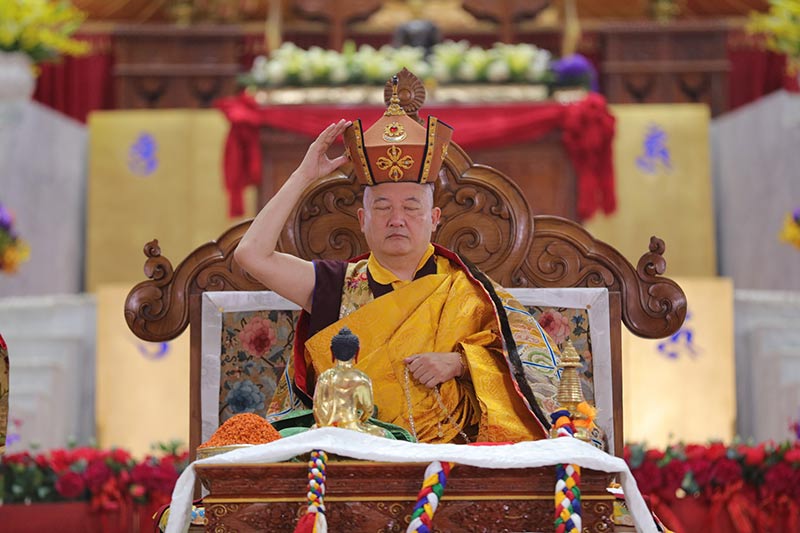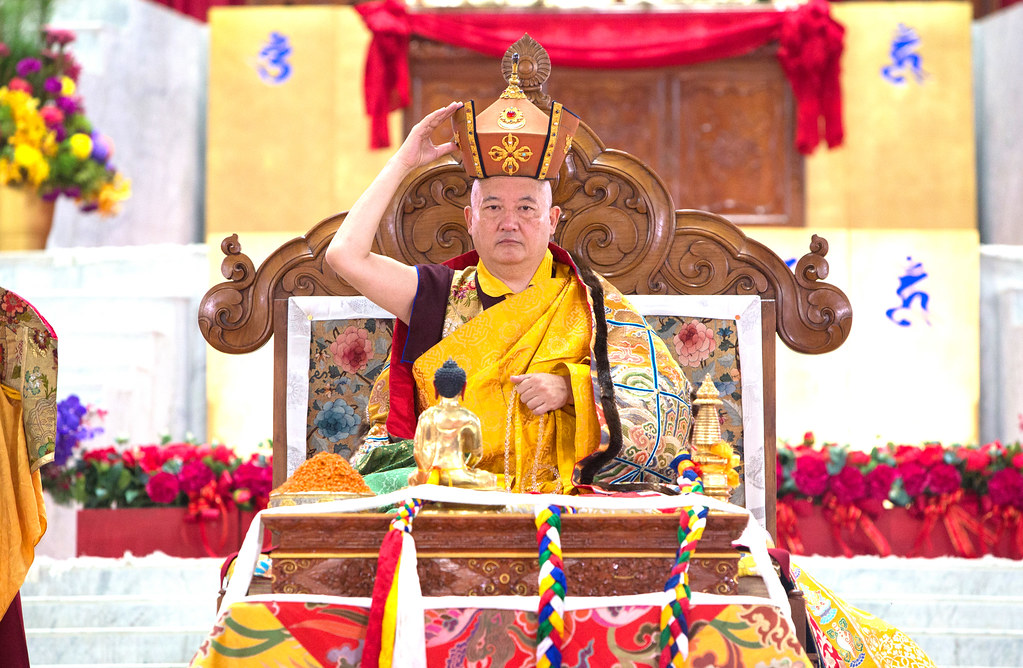
His Holiness Gyalwang Karmapa had expressed his wish for His Eminence Goshir Gyaltsap Rinpoche to auspiciously conclude the Kagyu Monlam with the Vajra Crown ceremony and longevity empowerments. Welcomed with a light rain shower cooling off the air, the Red Crown Ceremony commenced with three translators reading the special announcement that emphasized how the sacred donning of vajra crowns is a thongdrol a sacred moment which, when seen, plants the seed of liberation, and has liberated countless disciples. Vajra crown ceremonies are particular to the Karma Kamtsang practice lineage and exclusive to the Gyalwang Karmapa and his Heart Sons.
The text of the speech reads:
Om Svasti
Embodiment of the wisdom and compassion of all the victors,
Avalokita at the summit of Mount Potala,
The glorious Karmapa in the Land of Snow,
I prostrate to him whose fame stretches above all, like a white parasol.
Vajrapani, the vajra mind of all the victors,
Ananda, the repository of the victor’s teachings,
Regent of the supreme victor, Karmapa,
I prostrate at the feet of the great Goshir Gyaltsap.
On account of their exceptional resolve and aspirations, the buddhas and bodhisattvas engage in inconceivable awakened activity. Among these acts that are meant to be seen and heard is the ceremonial donning of vajra crowns. These sacred rituals which plant the seed of liberation upon sight have ripened and liberated countless disciples. This tradition of performing vajra crown ceremonies is particular to the practice lineage of the Karma Kamtsang and is exclusive to the Gyalwang Karmapas and his heart sons.
We find reference to crowns in both the vehicle of characteristics, the sutras, and in the vajra vehicle of the tantras. The sutras recount that before Shakyamuni Buddha appeared in this world, he was residing in the god realm of Tushita where he was known as Lha’i bu Dampa Tok Karpo. When departing the god realm for this world, he took his crown and placed it upon the head of the victor Maitreya, thus empowering him as his regent. It is said that Maitreya currently resides in Tushita performing the first of the twelve deeds of a supreme nirmanakaya—teaching to benefit the gods.
In the secret mantrayana, through the crown empowerment of Ratnasambhava, one is enthroned as a great universal ruler who lords over the three realms and is placed upon the great lion throne of the utter victory of non-abiding nirvana, free from the extremes of both conditioned existence and peace.
The black crown of the glorious Gyalwang Karmapas was presented to him long ago when he took birth as the sage Konpa on the northern side of Mt. Meru. At that time, the buddhas empowered him with a crown fashioned of single strands of hair from 320 million dakinis. Beings whose obscurations are subtle perceive the black crown as ever present above the head of all the incarnations of the Gyalwang Karmapas. But for the benefit child-like beings ensnared in a thicket of coarse obscurations, a physical black crown was fashioned—a symbolic representation of the true crown’s essence—and decorated with various precious gems and a golden blaze.
Each of the Gyalwang Karmapas has heart sons who are actually his emanations. As they are inseparable from him, the Gyalwang Karmapas bestowed upon them vajra crowns and commanded them to accomplish vast benefit for the teachings and beings. Together with his resolve, command of interdependence, and aspirations, the Karmapas enthroned them as Dharma Kings and thus arose the tradition of their vajra crowns.
Goshir Gyaltsap Rinpoche’s red crown originated with a prophecy. The Lotus-born Great Guru Padmasambhava prophesied to the Seventh Gyalwang Karmapa Chodrak Gyatso:
If the agent of the victor’s activity—
The emanation of Karchen Pelgyi Wangchuk
And Dromton Gyalwe Jungney—
Dons the crown that is the command of the guru,
It will create auspicious conditions
For the Buddha’s teachings to flourish.
Subsequently, a red crown with a golden blaze that liberates upon sight was consecrated through the practice of Lama Gongdu. Having been blessed as the essence of vajra speech, Amitabha, it was placed upon the head of the second Gyaltsappa Tashi Namgyal. Gyalwang Chodrak Gyatso then proclaimed that the mind of the teacher and student had become undifferentiated, and he appointed Gyaltsap Tashi Namgyal as his regent who will turn the wheel of Dharma. He continued, saying that with this Vajra Crown remaining inseparable from [the Gyaltsappas], it will create auspicious conditions to sustain all the Buddha’s teachings, in general, and in particular, the long-standing tradition that is the essence of the practice lineage. He then recited verses, scattering the flowers of auspiciousness.
When witnessing the donning of the Vajra Crown, you should have unwavering faith in the support, the Vajra Crown and focus one-pointedly on this exalted object. At that time and at all times, one should supplicate with devotion while meditating that the lama is the embodiment of all refuges and situated above your head, you should sustain the mind’s natural state without altering it; and you should strive to train in loving kindness, compassion and bodhichitta. These are the attitudes to hold during the ceremony and also the benefits of witnessing the ritual.
Those who possess black and red crowns, the Gyalwang Karmapas and their heart sons, are the crown jewels of the teachings and beings. By regarding them as the eyes in your forehead and the hearts in your body, you should rouse the three faiths: clear faith of an utterly lucid mind that is not contaminated by any obscuration of selfish attachment and aversion, the faith that longs to truly manifest the ultimate result, and the faith of conviction welling up from the depths of your being. Giving rise to these, you should sustain the nature of mind itself and train the mind in loving kindness, compassion, and bodhichitta.
The results of making effort in emanating clouds of offerings, making supplications, and forming aspirations when witnessing the vajra crown ceremony are as follows:
Those of supreme fortune will be granted
The qualities of the paths and levels upon beholding it.
For those of lesser fortune who have accumulated many negative actions,
Witnessing the crown ceremony will eradicate misdeeds and obscurations Accumulated over thousands of kalpas.
The most desirable things of this life will be obtained according to one’s wishes. By focusing on and supplicating you,
All hopes will be fulfilled accordingly.
Thus, all qualities of meditative experience and realization will arise without difficulty. All negative karma, misdeeds and obscurations will be dispelled. And all your intentions will be accomplished just as you wish.
May the glorious lama’s lotus feet be firm.
May happiness come to all throughout space.
May I and all others gather the accumulations, remove obscurations,
And swiftly be brought to Buddhahood.
After this announcement, Gyaltsap Rinpoche performed the Red Crown ceremony twice. He then bestowed the long life empowerment, explaining beforehand that the benefits of the empowerment of Amitayus are as limitless as space and it brings benefit to all sentient beings. While there are many empowerments of Amitayus in India and Tibet, this empowerment originates from when Marpa told Milarepa to bring different types of Dharma from India such as the Yogas of Naropa. Marpa said to Milarepa that there were many secondary pith instructions. He then said that it would bring great benefit if Milarepa would either go himself or send a student to retrieve these instructions. At this time, Milarepa sent Rechung Dorje Drakpa to India where he received empowerments of Vajrapani and Avalokitesvara.
During this time in India, Rechungpa’s lama told him that he would not have a long life. Rechungpa became afraid and asked what he could do. He was instructed to take a long-life empowerment from the queen of Mahasiddhis, to extend his lifespan. Rechungpa went to her and received a long-life empowerment. There are both short and long versions of this empowerment. Rechungpa brought both back to Tibet and gave them to his students who spread this empowerment into other traditions outside of Karma Kagyu.
Gyaltsap Rinpoche explained, “At the time Rechungpa took this empowerment, he was forty-four years old and was coming to the end of his life, but,by taking this empowerment, he was able to live until the age of eighty-one.” The empowerment had been passed down in the Karmapa lineage from the Second Karmapa Karma Pakshi onwards, and Gyaltsap Rinpoche had received it from the Sixteenth Karmapa Rangjung Rigpe Dorje. “So, by taking this empowerment,” he continued, “we will be able to live a long time. This is a time when the afflictions are prominent and there is a lot of impurity in the body, but by taking this empowerment, it restores our bodies and therefore helps us.”
Walking row by row, Gyaltsap Rinpoche kindly distributed blessings to all the people gathered in the pavilion, who waited with offerings, devotion, and humility.


































